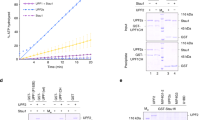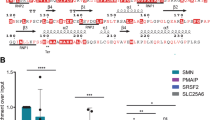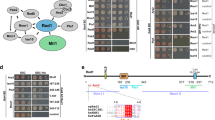Abstract
A conserved stem-loop motif of the constitutive decay element (CDE) in the 3′ UTR of mRNAs is recognized by the ROQ domain of Roquin, which mediates mRNA degradation. Here we report two crystal structures of the Homo sapiens ROQ domain in complex with CDE RNA. The ROQ domain has an elongated shape with three subdomains. The 19-nt Hmgxb3 CDE is bound as a stem-loop to domain III. The 23-nt TNF RNA is bound as a duplex to a separate site at the interface between domains I and II. Mutagenesis studies confirm that the ROQ domain has two separate RNA-binding sites, one for stem-loop RNA (A site) and the other for double-stranded RNA (B site). Mutation in either site perturbs the Roquin-mediated degradation of HMGXB3 and IL6 mRNAs in human cells, demonstrating the importance of both sites for mRNA decay.
This is a preview of subscription content, access via your institution
Access options
Subscribe to this journal
Receive 12 print issues and online access
$189.00 per year
only $15.75 per issue
Buy this article
- Purchase on Springer Link
- Instant access to full article PDF
Prices may be subject to local taxes which are calculated during checkout






Similar content being viewed by others
References
Garneau, N.L., Wilusz, J. & Wilusz, C.J. The highways and byways of mRNA decay. Nat. Rev. Mol. Cell Biol. 8, 113–126 (2007).
Beisang, D. & Bohjanen, P.R. Perspectives on the ARE as it turns 25 years old. Wiley Interdiscip. Rev. RNA 3, 719–731 (2012).
Brooks, S.A. & Blackshear, P.J. Tristetraprolin (TTP): interactions with mRNA and proteins, and current thoughts on mechanism of action. Biochim. Biophys. Acta 1829, 666–679 (2013).
Stoecklin, G., Lu, M., Rattenbacher, B. & Moroni, C. A constitutive decay element promotes tumor necrosis factor alpha mRNA degradation via an AU-rich element-independent pathway. Mol. Cell. Biol. 23, 3506–3515 (2003).
Leppek, K. et al. Roquin promotes constitutive mRNA decay via a conserved class of stem-loop recognition motifs. Cell 153, 869–881 (2013).
Glasmacher, E. et al. Roquin binds inducible constimulator mRNA and effectors of mRNA decay to induce microRNA-independent post-transcriptional repression. Nat. Immunol. 11, 725–733 (2010).
Vinuesa, C.G. et al. A RING-type ubiquitin ligase family member required to repress follicular helper T cells and autoimmunity. Nature 435, 452–458 (2005).
Yu, D. et al. Roquin represses autoimmunity by limiting inducible T-cell co-stimulator messenger RNA. Nature 450, 299–303 (2007).
Vogel, K.U. et al. Roquin paralogs 1 and 2 redundantly repress the Icos and Ox40 costimulator mRNAs and control follicular helper T cell differentiation. Immunol. 38, 655–668 (2013).
Pratama, A. et al. Roquin-2 shares functions with its paralog roquin-1 in the repression of mRNAs controlling T follicular helper cells and systemic inflammation. Immunity 38, 669–680 (2013).
Heissmeyer, V. & Vogel, K.U. Molecular control of Tfh-cell differentiation by Roquin family proteins. Immunol. Rev. 253, 273–289 (2013).
Ji, Y.R. et al. Enforced expression of roquin protein in T cells exacerbates the incidence and severity of experimental arthritis. J. Biol. Chem. 287, 42269–42277 (2012).
Bertossi, A. et al. Loss of Roquin induces early death and immune deregulation but not autoimmunity. J. Exp. Med. 208, 1749–1756 (2011).
Zheng, N. et al. Structure of the Cul1–Rbx1–Skp1–FboxSkp2 SCF ubiquitin ligase complex. Nature 416, 703–709 (2002).
Goldenberg, S.J. et al. Structure of the Cand1-Cul1-Roc1 complex reveals regulatory mechanisms for the assembly of the multisubunit cullin-dependent ubiquitin ligases. Cell 119, 517–528 (2004).
Scott, D.C., Monda, J.K., Bennett, E.J., Harper, J.W. & Schulman, B.A. N-terminal acetylation acts as an avidity enhancer within an interconnected multiprotein complex. Science 334, 674–678 (2011).
Scott, D.C. et al. A dual E3 mechanism for Rub1 ligation to Cdc53. Mol. Cell 39, 784–796 (2010).
Holm, L., Kaariainen, S., Rosenstrom, P. & Schenkel, A. Searching protein structure databases with DaliLite v.3. Bioinformatics 24, 2780–2781 (2008).
Soler, N., Fourmy, D. & Yoshizawa, S. Structural insight into a molecular switch in tandem winged-helix motifs from elongation factor SelB. J. Mol. Biol. 370, 728–741 (2007).
Schwartz, T., Rould, M.A., Lowenhaupt, K., Herbert, A. & Rich, A. Crystal structure of the Za domain of the human editing enzyme ADAR1 bound to left-handed Z-DNA. Science 284, 1841–1845 (1999).
Matsushita, K. et al. Zc3h12a is an RNase essential for controlling immune responses by regulating mRNA decay. Nature 458, 1185–1190 (2009).
Teichmann, M., Dumay-Odelot, H. & Fribourg, S. Structural and functional aspects of winged-helix domains at the core of transcription initiation complexes. Transcription 3, 2–7 (2012).
Athanasopoulos, V. et al. The ROQUIN family of proteins localizes to stress granules via the ROQ domain and binds target mRNAs. FEBS J. 277, 2109–2127 (2010).
Hendrickson, W.A., Horton, J.R. & LeMaster, D.M. Selenomethionyl proteins produced for analysis by multiwavelength anomalous diffraction (MAD): a vehicle for direct determination of three-dimensional structure. EMBO J. 9, 1665–1672 (1990).
Hendrickson, W.A. Determination of macromolecular structures from anomalous diffraction of synchrotron radiation. Science 254, 51–58 (1991).
Otwinowski, Z. & Minor, W. Processing of X-ray diffraction data collected in oscillation mode. Methods Enzymol. 276, 307–326 (1997).
Schneider, T.R. & Sheldrick, G.M. Substructure solution with SHELXD. Acta Crystallogr. D Biol. Crystallogr. 58, 1772–1779 (2002).
Terwilliger, T.C. SOLVE and RESOLVE: automated structure solution and density modification. Methods Enzymol. 374, 22–37 (2003).
Emsley, P. & Cowtan, K.D. Coot: model-building tools for molecular graphics. Acta Crystallogr. D Biol. Crystallogr. 60, 2126–2132 (2004).
Brünger, A.T. et al. Crystallography & NMR System: a new software suite for macromolecular structure determination. Acta Crystallogr. D Biol. Crystallogr. 54, 905–921 (1998).
Adams, P.D. et al. PHENIX: building a new software for automated crystallographic structure determination. Acta Crystallogr. D Biol. Crystallogr. 58, 1948–1954 (2002).
Jogl, G., Tao, X., Xu, Y. & Tong, L. COMO: a program for combined molecular replacement. Acta Crystallogr. D Biol. Crystallogr. 57, 1127–1134 (2001).
Jiao, X., Wang, Z. & Kiledjian, M. Identification of an mRNA-decapping regulator implicated in X-linked mental retardation. Mol. Cell 24, 713–722 (2006).
Acknowledgements
We thank X. Jiao (Rutgers University) for constructing the pTK-IREShyg and pIREShyg-Flag plasmids and N. Whalen, R. Jackimowicz and H. Robinson for access to the X29A beamline at the National Synchrotron Light Source. The in-house instrument for X-ray diffraction screening was purchased with a US National Institutes of Health (NIH) grant S10OD012018 (LT). This research is supported by NIH grants GM077175 (L.T.) and GM067005 (M.K.).
Author information
Authors and Affiliations
Contributions
D.T. carried out protein expression, purification and crystallization, X-ray diffraction data collection and processing, structure determination and refinement, mutagenesis and EMSA experiments. M.Z. carried out the mRNA stability experiments. L.T. and M.K. supervised the experiments, analyzed the data and wrote the manuscript. All authors commented on the manuscript.
Corresponding author
Ethics declarations
Competing interests
The authors declare no competing financial interests.
Integrated supplementary information
Supplementary Figure 1 Sequence alignment of Roquin proteins.
Sequence alignment of human (Hs), rat (Rn) and Danio rerio (Dr) Roquin (R1) and human Roquin-2 (R2). The secondary structure elements in the structure of the ROQ domain of human Roquin are indicated. Blue and red asterisks denote residues that interact with the Hmg19 and TNF23 RNA, respectively. Magenta triangles indicate residues predicted to coordinate the Zn atom in the zinc-finger motif.
Supplementary Figure 2 Structural similarity between domains II and III of the ROQ domain with winged-helix (WH) domains.
(a). Overlay of the structures of domain III of ROQ domain (in green) and the WH-B domain of cullin 1 (in gray). (b). Overlay of the structures of domain III of ROQ domain (green) and the WH motif of elongation factor SelB in complex with SECIS RNA (gray). (c). Overlay of the structures of domain II of ROQ domain (cyan) and the WH motif of ADAR1 in complex with Z DNA (gray). Produced with the program PyMOL (www.pymol.org).
Supplementary Figure 3 Sequence conservation of the CDE stem-loop among selected mRNAs.
(a). Alignment of CDE sequences in the 3' UTR of TNF α mRNA from various species, and the 3' UTR of other CDE-containing mRNAs. There may be a bulge in the 3' arm of the human IL-6 mRNA. (b). A schematic of an RNA that could bind simultaneously to both A and B sites of the ROQ domain.
Supplementary Figure 4 Two views of the electrostatic surface of the ROQ domain.
(Top) The Hmg19 RNA is bound to a mostly electropositive area in the surface of the WH motif in domain III. (Bottom) The TNF23 RNA is bound to a groove between domains I and II, with a mostly electropositive area in domain I. The two views on the right are nearly the same, and the two views on the left are related by 180° rotation around the vertical axis.
Supplementary Figure 5 TNF23 RNA is bound as a duplex in the crystal.
(Top Left) Two views of the composite omit Fo–Fc electron density map at 1.9 Å resolution for the double-stranded TNF23 RNA, contoured at 2.5σ. The red arrow points to the break in one chain, where nucleotide U10 is disordered. (Top Right) Schematic representation of the structure of the TNF23 duplex. (Bottom) Two views of the structure of TNF23 duplex in complex with two ROQ domains (in color and gray, respectively). There are no contacts with the nucleotides in the middle of the duplex, which correspond to the loop in the stem-loop structure. The red arrows point to the disordered U10 residue in one of the TNF23 molecules.
Supplementary Figure 6 Detailed interactions between the ROQ domain and the TNF23 RNA.
(a). Interactions of Arg131 with the G17 base in the ROQ-TNF23 complex (gray) where U1 and A–1 are disordered. The G17 base from the other complex is also shown (in orange). The red arrow indicates the change in the position of this base in the two complexes. (b). Interactions of Arg131 with the 3' end of the duplex and the 3' flanking sequence in the ROQ-TNF23 complex where U1 is flipped out. (c). Overlay of the structures of the two ROQ-TNF23 complexes in the crystal. One complex is in color, the other in gray. The overlay is based on the protein Cα atoms only. (d). Differences in the binding mode and conformation of the two TNF23 RNA molecules. (e). The local environment of Met199 in the structure of the ROQ domain. (f). The side chain of Met199 is partly exposed to the solvent. A partially transparent surface of domain III is shown.
Supplementary Figure 7 Uncropped images for Figure 4b.
The lanes that are shown in Fig. 4b (middle panel) are highlighted with the red boxes
Supplementary information
Supplementary Text and Figures
Supplementary Figures 1–7, Supplementary Table 1 and Supplementary Notes 1–4 (PDF 12339 kb)
Rights and permissions
About this article
Cite this article
Tan, D., Zhou, M., Kiledjian, M. et al. The ROQ domain of Roquin recognizes mRNA constitutive-decay element and double-stranded RNA. Nat Struct Mol Biol 21, 679–685 (2014). https://doi.org/10.1038/nsmb.2857
Received:
Accepted:
Published:
Issue Date:
DOI: https://doi.org/10.1038/nsmb.2857
This article is cited by
-
Transcriptome alterations in peripheral blood B cells of patients with multiple sclerosis receiving immune reconstitution therapy
Journal of Neuroinflammation (2023)
-
Structural basis for recognition of transcriptional terminator structures by ProQ/FinO domain RNA chaperones
Nature Communications (2022)
-
Disrupting Roquin-1 interaction with Regnase-1 induces autoimmunity and enhances antitumor responses
Nature Immunology (2021)
-
A human immune dysregulation syndrome characterized by severe hyperinflammation with a homozygous nonsense Roquin-1 mutation
Nature Communications (2019)
-
Binding of NUFIP2 to Roquin promotes recognition and regulation of ICOS mRNA
Nature Communications (2018)



